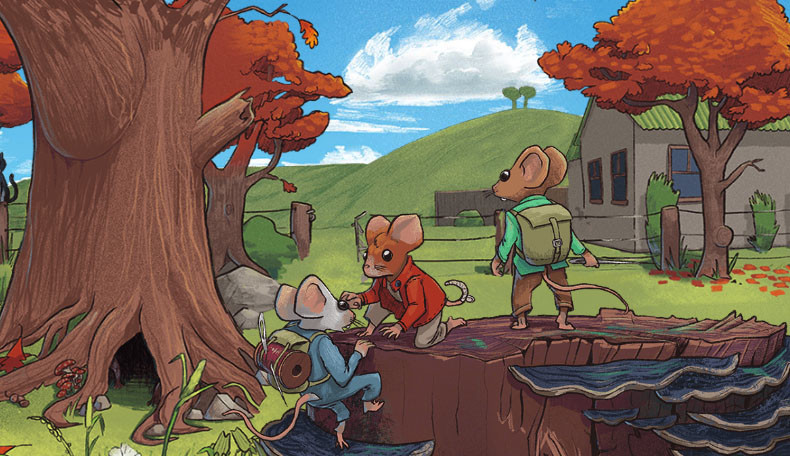Review of Shadow of the Demon Lord

After Benjamin let us create a village Beyond the Wall and Katrin took us with Tales from the Loop into the other 80s, it was my turn to introduce a game system. I brought my nice red leatherette german edition of Shadow of the Demon Lord and two self-written adventures to the table. The journey was to take place in a village called Leiden in an empire on the brink of collapse…
Shadow of the Demon Lord is a roleplaying game system by Robert J. Schwalb, who was involved in Warhammer Fantasy, A Song of Ice and Fire Roleplaying Game, the 4th and 5th edition of Dungeon and Dragons, of the setting Freeport and Monte Cook’s Numenera.
This post contains affiliate links, which are marked with a “*” in the name.

- Publisher: Schwalb Entertainment, LLC
- Release Year: 2015
- Language: English
- Pages: ca. 272
- Format: PDF / Softcover / Hardcover
- Price: 18.99 $ (PDF) / 41.99 $ (Softcover)
- Available at: DriveThruRPG*
Review from the perspective of the Game Master
Setting
The setting of Shadow of the Demon Lord is Warhammer-esque Fantasy and the world is presented in Grim-Dark Fantasy style with the idea of a dying empire. The moral decay and corruption of humans and other races is in focus. Additionally, the Demon Lord threatens the world with his presence and cult followers of the Demon Lord try to accelerate the downfall of Urd.
The main continent of the world Urd is Rûl. The emperor of the empire of Caecras died by the orc rebellion in the empire. Countries, duchies and baronies of the empire are thus left to themselves. Behind the mountains of the former empire there are swarms of animal men, who are just waiting for a chance to tear down the walls of the empire. The followers of the old faith are colliding more and more often with the believers of the new god. Unknown to many, the demon lord casts his shadow and prepares his attack on Urd.
The core rules describe the setting on a good 26 pages and leave enough space for your own interpretations or the regional volumes that have been or will be published. The brevity of the setting description is also underlined by the continental map of Rûl and the Northern Reach area, because there are some villages without names in the map. Places to be explored. Places that should be freely designed for the adventure or the campaign.
Nevertheless, the cities and regions of Rûl are described to the extent that one gets a good picture of them. Besides geography, religions, gods, the history of the fairy queen and her people, but also witchcraft are described together with the different dimensions of the cosmology. Always trying to present the reader with as dark a picture of the world as possible. The powerful mages of Caecra are unreachable and have apparently moved into their flying mage tower above the former imperial city. The city of Dis, the city of chains, is known for its huge slave market and villages as well as smaller towns are more than ever at the mercy of their princes without an emperor.
Ancestries
The races described in the core rules, which are called Ancestries, are described appropriately for the setting. Orcs are not the evil greenskins that come from the mountains and have a feud with the dwarves, but were magically created by humans as battle slaves by the blood of the giants.
The goblins are cursed fairies who lost their immortality and mostly live in sewers of cities and collect and rummage through garbage. Changelings were created by fairies to replace the children who were kidnapped by the fairies.
The dwarves have their connection to other settings and were created by their all-father, but also cursed to pursue their greed for gold and dig for treasure in the mountains. Last but not least there are the clockworks, which house a stolen soul from the underworld.
Character Creation
Character creation in Shadow of the Demon Lord is quick and easy using random tables. Of course you can also do without the dice and choose the right one, but where is the fun without a little bit of randomness ;-).
Each ancestry has basically fixed values for the four attributes (Strength, Agility, Intellect, Will), the speed of movement, size and the derived attributes such as Health, Healing Rate and Perception. However, each character may increase one attribute by 1 once, but must decrease another attribute by 1. Some ancestries, like the orcs, start with corruption, which is a decay of the soul.
The random tables already mentioned are used to determine appearance, age and other characteristics of the character. Each ancestry has its own tables. Subsequently, further tables are used to quickly determine which professions the character has practiced so far, what his personality looks like (1 positive and 1 negative trait each, e.g. courageous and conceited) and which interesting detail the character has (e.g. a bloodstained doll or a small golden cage with a mute fairy). Finally, dice up the belongings and off you go.
The System
As with Call of Cthulhu and Warhammer, the soul becomes corrupted and the mental state of the character deteriorates. This is depicted through madness and corruption. If the value is too high, the character develops a mental illness or the influence of the Demon Lord on the character shows in other ways.
A very nice rule and special feature in this system is the initiative in the fight. The actions in the game that a character can perform can be represented in action, reaction and movement action. At the beginning of each combat round, the players decide by means of a coin or other game materials (in our case cards) whether they want to make a slow turn or a fast turn. A slow turn allows a movement action and the execution of an action. A fast turn allows for a movement action or an action. The order of play in combat is as follows each round: Player characters with fast turns, game master characters with fast turns, player characters with slow turns, game master characters with slow turns. For more randomness, at the beginning of each round the dice can be rolled between players and the game master to decide whether this order is in favour of players or game master.
Skill Checks
Shadow of the Demon Lord is a d20 game and has a strong reference to Dungeons and Dragons 5e. Since the 5th edition of DnD has been simplified and the focus is on a faster gameplay in contrast to the previous versions, Shadow of the Demon Lord also benefits from this.
A check is successful if a result of 10 or higher is achieved. Attacks, spells or other abilities can have an additional effect when the die roll is 20+. For example, no spell usage is consumed or you deal more damage. A fumble or critical success mechanic is not part of Shadow of the Demon Lord.
Checks are made by throwing a d20 and considering modifiers and advantages as well as disadvantages. These advantages or disadvantages are called by the game master in certain situations, e.g. visibility in heavy rain, darkness, secret attacks, etc. For each advantage / disadvantage you roll a d6. If there are multiple advantages / disadvantages, however, only the highest die roll result of the d6 or the lowest result is taken.
The character’s professions are designed to reduce the checks and show what the character can do without a skill check. A tracker can thus recognize and follow tracks based on his professional experience. This reduces the amount of dice rolls at the table and allows a more fluid play.
Character Advancement
The characters start their adventure at level 0, and the game system and rules focus mostly on combat skills. This should not stand in the way of role-playing, but it does not encourage it much. However, Robert Schwalb has also included one or two hints like the optional bond rule. Relationships between characters should be established like in other roleplaying games (e.g. Dungeon World, Tales from the Loop) and motivate a deeper connection between the characters.
At levels 1, 3 and 7 the characters have the possibility to choose a novice, expert and master path (alternatively to the master path a 2nd journeyman path). There are 4 novice paths, 16 expert paths and 64 master paths to choose from. The character development therefore starts relaxed with the question: warrior, rogue, magician or priest? and ends with the agony of choosing between apocalyptist, summoner, gunslinger or technomant.
Every time you choose a path you may also increase attributes. On the other levels you get more abilities, more Health or you can choose new spells. The latter is described very lavishly in the book and you first have to explore the magic schools either by leveling up or finding books. So there is not a completely free choice of spells, but the characters will inevitably specialize in certain spell schools.
One Book to rule them all
The book reads fluently, describes the world and idea of the game system beautifully and offers two good sales arguments in my opinion. The first argument is that in the core rules you will find the rough setting, the rules, the spells, the game master section (with helpful tips & tricks for beginners and veterans) and bestarium. It is a player’s guide, a game master book and a bestarium in one.
The second argument is the length of adventures and campaigns. Adventures are usually between 2 and 7 pages long. The idea of Shadow of the Demon Lord is that working people, parents or otherwise involved groups of people don’t necessarily have the time for a 2+ year campaign with weekly play sessions. An adventure in this game system is usually written for one game night. A group advancement usually follows analogously to the survival of the adventure. The maximum level of 10 is thus reached in the course of about 11 adventures. This is therefore also the targeted length of a campaign. Thus a campaign can be completed in 11 game evenings. However, if this is not enough, you can probably also agree that not every adventure will be upgraded one level and thus you can complete several adventures on the same group level.
With book and PDF you can work perfectly. The only disadvantage at the table, if you only use the book: Players have to look something up from time to time and the game master has to look into the bestarium.
Review from a Player’s Point of View
When René told me about the new system that he had discovered, he described it as a dark Dungeons and Dragons variant. He was especially enthusiastic about the fact that Robert Schwalb had also been involved in the creation of the 5th edition Dungeons and Dragons and therefore knew about its rough edges.
The Beginning
At first, Shadow of the Demon Lord looks like a marriage from an old-school revival system (OSR) and Dungeons and Dragons 5e. You start at level 0, the enemies are deadly and the choice of classes at level 1 is limited to four.
I especially liked the tests of willpower of the still inexperienced characters who are confronted with abnormal creatures and situations. The creators of the system have successfully tried hard to reproduce the stress of such a profession. You accumulate more and more insanity until you develop nervous tics (or worse).
The character sheet has attracted negative attention. Although the idea of a pentagram for attributes is definitely interesting and looks stylistically very good, there is far too little space on the sheets for all the information you have to write down about your character. Fortunately the internet is always good for some alternative sheets.
Advancement
Here we come to the part of the system that makes Shadow of the Demon Lord shine for me. Clearly, the system is designed for working people who can’t invest that much time. The fast character development is something that I personally like a lot and every level-up is associated with a noticeable increase in skills.
The focus is particularly on the class system, which is much less rigid than in comparable systems. No matter which of the four starting classes is chosen, all 16 expert classes are available at level 3. Each with its own strengths and weaknesses, which can be combined excellently with many other classes.
For example, I started as a magician, but at level 3 I chose a spellbinder. The spellbinder is a class from the combat section and is a warrior who can fight with a magical weapon summoned by him. Standing in close combat with a magic sword and throwing alternate blows and storm, fire and earth magic in the face of the enemy is definitely very entertaining.
As someone who enjoys playing spell casting characters, it was a pleasure for me to learn how to set the number of spells that can be cast in Shadow of the Demon Lord. Every single spell you learn can be cast X times a day depending on your power. This leads to a bit of accounting, but makes magically gifted characters immensely versatile. No spell is left by the wayside because you have already spent your magic elsewhere.
All in all, Shadow of the Demon Lord definitely deserves attention. In my eyes it is a worthy competitor to Dungeons and Dragons, which is probably a bit too similar to it to be able to assert itself on the same scale. In my case, I could just as well imagine playing my campaigns with this system and I wouldn’t miss anything.
Conclusion
Sebastian
Shadow of the Demon Lord is a very well done change from the often used 5th edition Dungeons and Dragons. For me, fast character development, dynamic initiative and free choice of class combinations without a noticeable disadvantage are the driving advantages of this system. If you are already familiar with D&D 5e you will quickly find your way around and spend some fun evenings.
René
You can see the influences of the past works, which Robert Schwalb helped to create. These influences also lead to an easy, fast and fluent playing. At the beginning of the campaign you have the end in sight and focus on the core of the story instead of playing a campaign over years and getting lost in side scenes.
The monsters are deadly and have a nice balance between hard to hit and life points sandbag. The spells are partly very creative and offer more than just a funny moment at the table.
Only the number of abilities may be fatal at higher levels. In addition, the character sheet offers too little space to master this number of spells and abilities.
Otherwise a very successful roleplaying game for the death-defying or the gloomy evening with friends!
Opinions of the Players
Benjamin
If you’re up for a dark world like Warhammer’s, but prefer to roll d20 instead of d100 and want to be able to do something with your character, you might feel comfortable with the Demon Lord. The system is uncomplicated and the combinations of professions, talents and spells are gigantic.
Like:
• Fighting and spellcasting with the same character rocks!
• Advancements linked to adventure ensure a quick sense of achievementSucks:
• A lot of paperwork on a suboptimal character sheet
Not for everyone:
• Random character creation
• Clear focus on combat and “task completion” leaves less room for character play
Katrin
I had my initial difficulties with the demon lord in the beginning. The dark world and the two ancestries changeling and clockwork aroused my interest, the first session felt like a simple DnD variant due to the reduction of attributes and the kind of checks.
But then we got a few levels up and here the demon lord is really brilliant! The classic fantasy systems frighten me off because of the fixation on one class and the rather one-dimensional character creation that comes with it. For me, this is clearly where the strength lies with the demon lord. Personally I don’t like to play magic classes, but the combination of transformation, healing magic and witchcrafting really rocked! Furthermore the spells are extremely creative and this also applies to healing magic (Hallelujah!). Conclusion from me, on a higher level the Demon Lord is a clear recommendation even from a fantasy sceptic!








